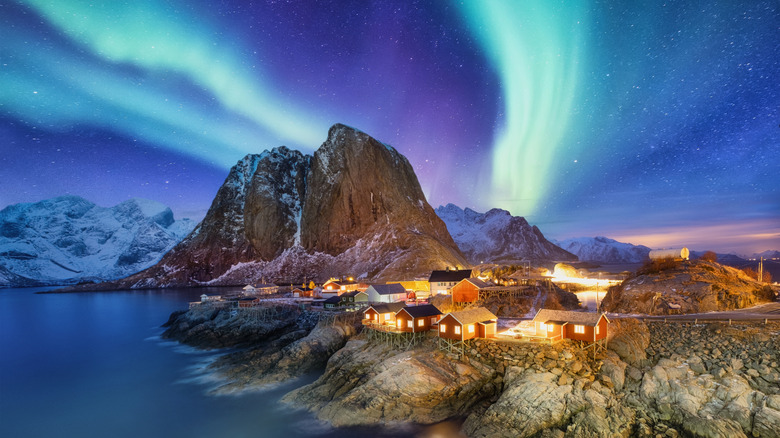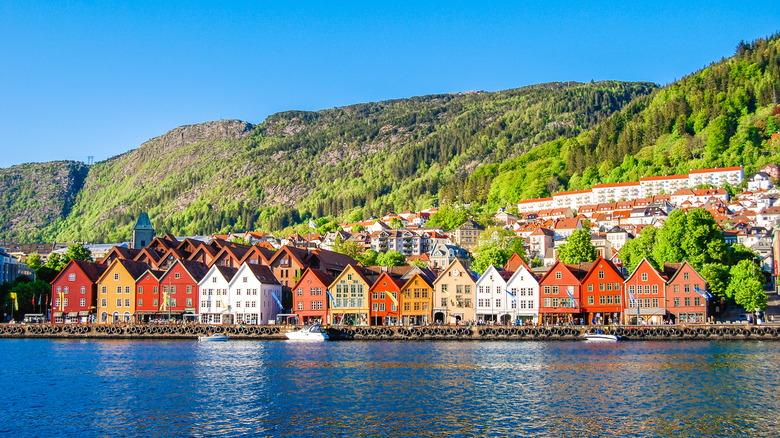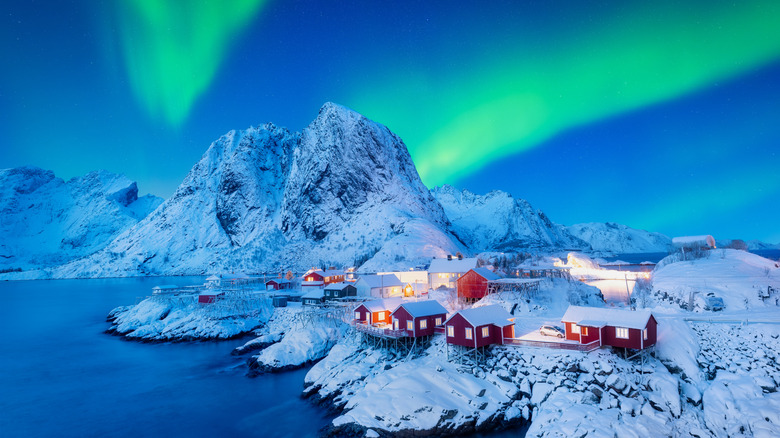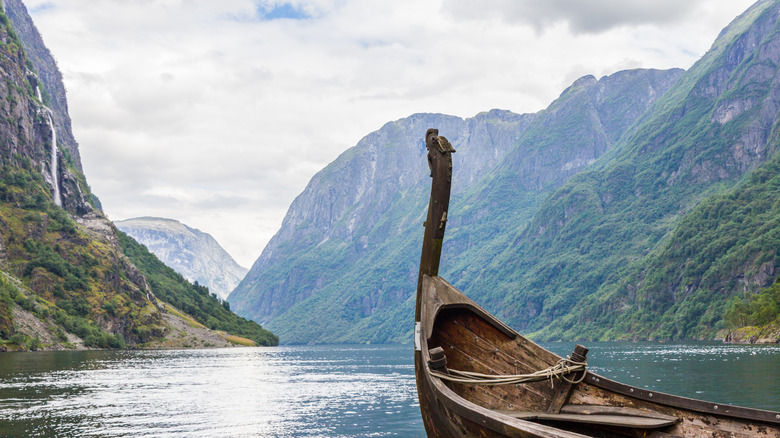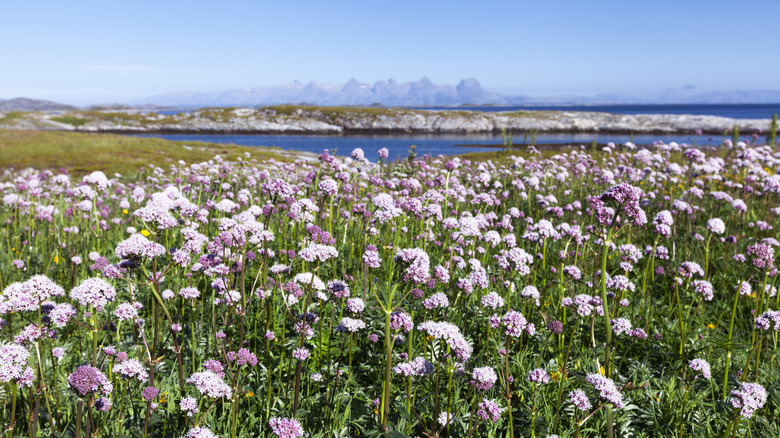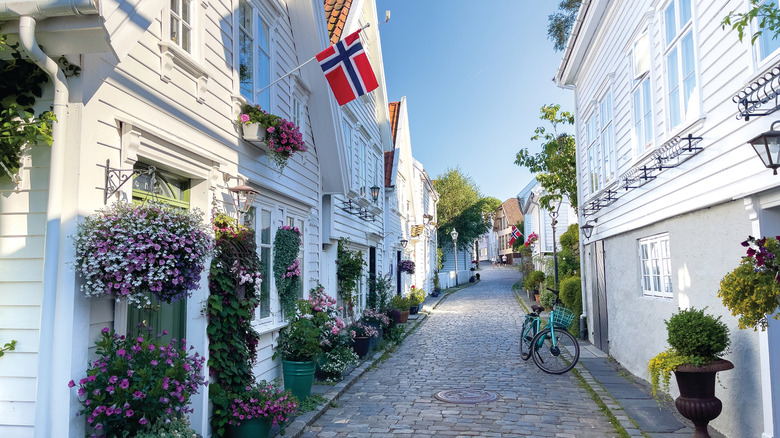Norway's 11 Prime Sights And Tourist Attractions For Your First Trip
Norway easily claims a spot as one of the world's most beautiful countries, brimming as it is with some of the most photogenic spots on the planet. Its famous fjords, carved over centuries by the sea and glaciers, need to be seen to be believed. And the fjords are just the beginning, as they cut through stunning landscapes characterized by Europe's biggest glaciers, wildest mountains, deepest forests, most charming towns, and waterfalls dramatically cascading down cliffs. Add in the ancient Viking culture, myths and legends, and it must be said: Norway is simply magical.
While Norway is undeniably incredible, it's also massive, and for a first-timer, it's tricky to narrow down just what to see. For this list, we've chosen to focus on Norway's most impressive sights located on, or near, the mainland. Norway may be known for its fjords, but also so much more, which you'll soon discover in this guide. We've compiled 11 of Norway's prime sights and attractions for your first visit. In addition to its majestic fjords, this list includes Norway's most vibrant cities, delightful island archipelagos, dramatic peaks, historic districts, and engineering marvels. Norway is all you've heard about and more, and here's everything worth seeing while you're there.
Bergen
Bergen offers the best of Norway in one city: mountains and ocean, fjords and fish markets, historic buildings and cobbled streets, forested hills and wooden churches. Norway's second-largest city is an underrated gem — one visitor on Reddit called it, "by far the most beautiful city I've seen," where "everything looks like it came out of a postcard." Founded in 1070, it became an important center of trade in the 13th century. Today, Bergen is a bustling hub with a maritime feel, charming streets, excellent seafood, and interesting museums, with seven iconic mountains as its backdrop.
Bergen's most photographed site is Bryggen, a colorful wharf and designated UNESCO World Heritage Site. Once the city's center for trade, Bryggen is now a warren of historic alleys and buildings, still dominated by merchants now primarily selling crafts and souvenirs. From Bryggen, it's a short walk to Bergen's sprawling fish market, an essential stop for any seafood lover. Venture farther outside of town for a ride up the Fløibanen funicular, which takes you up to the top of one of Bergen's seven mountains, Mount Fløyen. At the top, you'll have access to trails, lakes, an adventure park, and, of course, jaw-dropping views of Bergen and its surrounding fjords, islands, and mountains.
Lofoten Islands
When it comes to outstanding beauty in Norway, the Lofoten Islands encapsulate it all in one destination. Dramatic peaks rising above the ocean, quaint fishing villages dotted with red houses, and the backdrop of northern lights — or the midnight sun, depending on when you visit. Nestled in Norway's Arctic wilderness, these islands have some of the world's best beaches. The Lofoten Islands are often considered the most beautiful destination in Norway, which is really saying something. One traveler on Tripadvisor describes it as "a place where mountains, water, land, and sky combine in always-different ways."
In northern Norway, just above the Arctic Circle, the Lofoten Islands can be reached by car or bus. Most of the islands within the archipelago are connected by a network of unbelievably scenic roads, although the more remote can only be reached by boat. You can also take a ferry from Bodø or hop on a plane to the major islands, like Vestvågøy, where you'll find one of the region's main hubs, Leknes. Leknes is an ideal place to discover all that Lofoten has to offer, including Viking history, outdoor adventures like hiking and skiing, local culture, and fresh seafood.
Oslo
Norway's capital city is exceedingly lovely to visit. Castles, fjords, stunning modern buildings, and plenty of access to Norway's famous nature, Oslo is peak Norway. While it is often overlooked by visitors rushing to Norway's most famous natural attractions, be sure to save some time to explore this lively, fun capital —you won't be sorry that you did. Wander along the city's revitalized waterfront, and stop at sights like the Nobel Peace Center, the Munch Museum, and the iconic Oslo Opera House, built to resemble an iceberg. Climb to the top for amazing panoramic views —it's basically a tourist rite of passage. Another highlight of Oslo is the 14th-century Akershus Fortress, an enchanting medieval castle that inspired the Disney film "Frozen."
Oslo is situated near the picturesque Oslofjord, ideal for island-hopping by local ferry. The nearest, Hovedøya, is home to medieval ruins, and is a nine-minute ferry ride from the mainland. Farther out are the hiker-friendly Langøyene and Lindøya islands, known for bright-hued cabins and countless trails. The Oslofjord is also home to the city's famous floating saunas, where you can pair a good Norwegian sweat with a dip into the cold waters of the fjord. Just outside of Oslo near the Oslofjord is the Norwegian Folk Museum, a fascinating open-air museum that takes you back in time through Norway's long history.
Sognefjord
Norway is all about the fjords, and the longest and deepest of them all is Sognefjord, north of Bergen. The Sognefjord, or the "King of the Fjords," stretches for 127 miles from the west coast inland, carving its way through glacial landscapes, past traditional villages, near waterfalls, and by the foot of massive glaciers. It's so large that it has several arms, or mini-fjords that stretch out from Sognefjord itself, such as Lustrafjord, Aurlandsfjord, and Nærøyfjord, a UNESCO World Heritage Site.
To truly appreciate fjords, you need to see them from both the water and from above, if possible. To do this on the Sognefjord, take a kayak or boat tour — one of the best adventures in the fjords of Norway — which often include pit stops at spectacular viewpoints like Stegastein, overlooking Aurlandsfjord. Many tours are round-trip from Bergen, and ideal base to explore the Sognefjord. If you have more time, consider staying in one of the charming towns right on the fjord, like Fjærland, Undredal (try the famous goat cheese), or Solvorn. From Solvorn, take a short ferry ride across Lustrafjord to one of Norway's most incredible monuments: the UNESCO-designated Urnes Stave Church, one of the oldest and best-preserved of Norway's famous wooden stave churches.
Nærøyfjord & Geirangerfjord
Two of Norway's western fjords, Nærøyfjord and Geirangerfjord, have earned a coveted spot on the UNESCO World Heritage list, deservedly so. With steep canyon walls stretching high from the water, lined with dozens of picturesque waterfalls that cascade right into the fjord itself, these two fjords are considered some of the most beautiful landscapes in Norway, and the world.
Nærøyfjord is most famous for its "Norway in a Nutshell" tour, which traverses the fjord while transferring between Oslo and Bergen, with a ride on the impressive Flåm Railway, one of the world's most beautiful train journeys. It's also the narrowest fjord in the world, with certain sections just 820 feet wide, making the dramatic 5,000-foot cliffs even more astounding. While many do the tour in just one day, consider spending a night on the Nærøyfjord in the Viking village of Gudvangen before taking the ferry to Flåm. Stay in a grass-roof house, take part in Viking activities, kayak in the fjord, and gaze in awe at the many surrounding waterfalls.
Just 75 miles from Nærøyfjord is Geirangerfjord, known for its gravity-defying farms clinging to the cliffs and its many incredible waterfalls. Some of the most famous falls, best seen by ferry from Geiranger to Hellesylt, are the Seven Sisters, the Suitor, and the Bridal Veil. Stay in the touristy town of Geiranger for the best views and to take the incredible Waterfall Walk from town to the Norwegian Fjord Centre, where you can learn all about the geological processes that create fjords. You can also base yourself in the gorgeous city of Ålesund for easy(ish) access to the Geirangerfjord.
Ålesund
Scattered over several islands on Norway's Atlantic Coast, you'll find Ålesund, Norway's gorgeous art nouveau town where mountains and fjords meet the ocean. Unlike most of Norway, Ålesund has a distinct architectural style, primarily due to a fire in the early 20th century that left approximately 10,000 people homeless. The city was rebuilt in the popular style of the time, and it paid off — nowadays, Ålesund enjoys a reputation as one of the most beautiful cities in Norway.
Even if architecture isn't your thing, you'll appreciate the decorative, colorful facades lining the canals and harbors, enhanced by the stunning natural surroundings. Begin your trip with a short yet challenging trek up to Aksla, a viewpoint to soak up the scenery and get the lay of the land. Ålesund is often used as a jumping-off point to explore the region's breathtaking scenery, including the famous Geirangerfjord, a day trip on the breathtaking Atlantic Ocean Road, or hiking on Godøya Island, about 40 minutes from the city.
Within Ålesund, there is plenty of fun to be had, as well. Kayak through the center along the picturesque Brosundet Canal, head out to the Atlantic Sea Park to visit the aquarium, or don a wetsuit and grab a surfboard if you're feeling adventurous. Ålesund also has a selection of intriguing museums, such as the Waldehuset, or "the House That Did Not Burn," the only dwelling in the eastern district to survive the fire. About five minutes outside of town is the Sunnmøre Museum, an open-air museum featuring historic homes and boats. To learn more about the city's signature architecture, a visit to the Art Nouveau Centre, or Jugendstilsenteret, is a must.
Tromsø
Tromsø is a place that totally transforms depending on the season, and this is reflected in several of its nicknames: "the Arctic Capital," or "the Paris of the North." The largest city in northern Norway, Tromsø lies over 200 miles north of the Arctic Circle — in the summer, it's all about the midnight sun, while in the winter, it's all about the northern lights. Winter is Tromsø's peak tourism season, so be sure to plan your visit well in advance. Visitors in the winter also come for the whale watching, dog sledding, ski touring, snowshoeing, and a New Year's Eve concert in the dramatic Arctic Cathedral. Another recommended winter activity is reindeer sledding, where you'll learn about reindeer herding and the local Sami culture. Sami culture thrives in Tromsø, with multiple Sami-focused events, including "Sami Week" in February, which features both a reindeer race and a lasso-throwing championship.
Tromsø shines in other seasons, too. Go on a puffin-watching cruise in the summer, followed by hiking, kayaking, and a sauna-swim session. Fall and spring offer greater chances of spotting northern lights, but the nights are also shorter. The city comes alive with autumn colors in September, and the views from the top of the Fjellheisen cable car are unbeatable.
With its popular university, a large array of festivals throughout the year, an innovative culinary scene, a lively selection of boutiques, and a thriving nightlife, it's not surprising that Tromsø is one of Norway's main hot spots. And, unlike other cities in Europe, the fun really heats up in the heart of winter.
Mosjøen & the Helgeland coast
The Helgeland coast, home to one of Norway's cutest towns, Mosjøen, has a legendary air about it. Perhaps it's the famed Seven Sisters Mountain Range, so vast that it seems to graze the sky. Or, maybe it's the Vega Islands, where islanders consider it their sacred duty to watch over the local ducks. Helgeland lies in Nordland, a region in northern Norway, and is often considered one of Norway's hidden gems. Helgeland's oldest town is Mosjøen, known as Norway's "Christmas Town" with charming 19th-century homes, a beach, zipline, and, of course, easy access to the rest of gorgeous Helgeland. It also boasts the world's longest porridge table during the annual Christmas holidays.
One of Helgeland's iconic destinations is the UNESCO-recognized Vega Archipelago, or Vegaøyan, famous for its conservation efforts to protect migrating eider ducks and their habitats, and then harvesting eiderdown to fuel the local economy. The farms, fishing villages, lighthouses, and charming harbors are a testament to many generations of sustainable living.
For a chance to spot those adorable puffins, head out to sea to Lovund Island, where a resident puffin colony returns every April and stays until August. Another highlight of Helgeland is the Seven Sisters range, a legendary coastal mountain chain that's particularly popular with hikers. For an overview of Helgeland, drive along the gorgeous Scenic Route Helgelandskysten, which traverses the coastline.
Trolltunga
You've seen the pictures: a daring traveler standing on a sharp rock jutting over far-below fjords. That's Norway's very own Trolltunga, or Troll's Tongue rock formation. This underrated European destination offers breathtaking hikes, but be warned that the trek is long and demanding, taking approximately 8 to 12 hours, depending on the route you take. Ranging from 12 to 16 miles round-trip, it's a steep ascent from the stunning fjord landscape to the astonishing rock formation, standing high at nearly 4,000 feet above sea level.
An unfortunate number of mountain rescues occur at Trolltunga each year, so it's highly recommended that even experienced hikers hire a knowledgeable local guide. The weather is unpredictable and can change on a dime, even in the summer, so be sure to wear layers, good-quality shoes, and the right gear. And don't forget a plethora of water and extra snacks.
Trolltunga has two primary seasons for hiking. The summer season lasts from early June to the end of August, and typically offers the best conditions. Early October to May is considered winter, when hiking with an experienced guide is strongly encouraged. Whenever you decide to go, make sure to do your research, start the hike early, and allot at least two days for the journey in case of inclement weather.
Jostedalsbreen National Park
Visit Europe's largest glacier and immerse yourself in mind-blowing scenery at Jostedalsbreen National Park, located in Nordfjord, a top-tier getaway with captivating nature views. Jostedal Glacier, or Jostedalsbreen, is the main feature of the park, which itself spans 188 square miles and covers a significant portion of the park's 550 square miles. Join a tour to walk on the glacier, or travel along the lush valley at the base of the glacier's most scenic arm, the stunning blue Briksdalsbreen.
Kayak near glaciers, hike past waterfalls, or journey on to picturesque Nordfjord, located in the northern reaches of the park. On Hoven Mountain, at the edge of Nordfjord, is one of the world's steepest aerial cable cars, the Loen Skylift. At the top, you can soak up the views from the on-site restaurant or hit one of the hiking trails. Whisk back down and climb into a kayak to glide on the pristine ocean at the bottom of the fjord, or visit one of the region's signature fishing villages. In this region, adventure abounds around every corner.
Stavanger
Beaches, fjords, a charming old town, a long Viking history, and a whole lot of oil — that's Stavanger, Norway's lively and lovely energy capital. One of the oldest settlements in Norway, Stavanger lies on the southwest coast, or the "Edge of Norway." Visit some of the city's oldest buildings in Gamle Stavanger, or Old Town, filled with cobblestoned streets and historic white buildings. Near the harbor is "Fargegaten," Stavanger's most colorful street, as well as the Stavanger Cathedral, Norway's oldest cathedral dating back to 1125.
Like most of Norway, many of Stavanger's most stunning sites are found in nature. Just over an hour from Stavanger is the Lysefjord, which features two of Norway's most iconic rocks: Pulpit Rock and the Kjerag Boulder. Pulpit Rock, or Preikestolen, is a breathtaking flat rock formation standing tall over the fjord, while the Kjerag Boulder, or Kjeragbolten, is a gravity-defying boulder wedged between two cliffs over 3,000 feet high above the fjord landscape. Both rock formations require a good amount of hiking to reach, so be sure to plan ahead. However, you can see both from below on a boat tour through the Lysefjord.
Outside of Stavanger in Hafrsfjord stands Sverd i fjell, or the "Swords in Rock" monument, dedicated to the Viking battle in 872 that unified the kingdom of Norway. The three stone swords sticking straight out of the ground, with hilts inspired by ancient Viking swords discovered throughout Norway, are said to symbolize peace, unity, and freedom.
Methodology
This guide of Norway's prime sights for first-time visitors is based on a combination of my personal experiences, recommendations from travel experts in Norway, feedback from previous visitors on Reddit forums and TripAdvisor reviews, as well as local tourism boards. Given Norway's incredible diversity, this list represents both its natural wonders and cultural offerings in its cities and towns. The destinations range from Norway's most urban landscapes to its most remote, in an effort to capture the best of this vast and extraordinary country.
